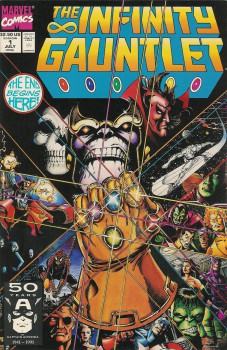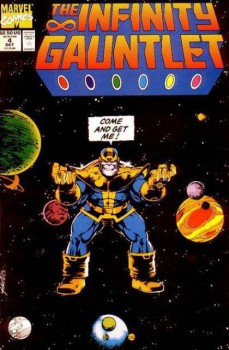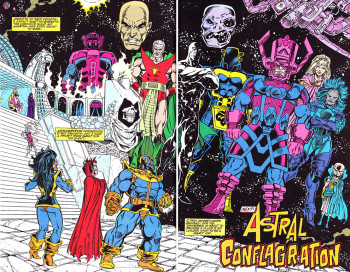The Three Phases of Adam Warlock: Return from the Dead
 I’ve been taking a look at Adam Warlock, one of my favorite comic characters. In previous posts, I’ve written about his early period as a failed messiah figure on Counter-Earth in the early- and mid-1970s, and then his Jim-Starlin-written tragic middle period as the cosmic champion of life, which led to his heroic death in 1977.
I’ve been taking a look at Adam Warlock, one of my favorite comic characters. In previous posts, I’ve written about his early period as a failed messiah figure on Counter-Earth in the early- and mid-1970s, and then his Jim-Starlin-written tragic middle period as the cosmic champion of life, which led to his heroic death in 1977.
Today, I want to take up the thread of the Adam Warlock saga fourteen years later, when both he and the Champion of Death, Thanos, were resurrected as the core of a massive cross-over event called The Infinity Gauntlet.
This may be timely for some folk who had never read the original or reprinted Warlock runs, because Marvel movies have already teased us with a hero-sized cocoon in a Thor movie and have announced an Infinity War movie for 2018.
So, since the Infinity Gauntlet series is now 24 years old, I’m not going to issue spoiler alerts; I’ll likely just berate you for not having read this already (you can, incidentally, stop reading this post, go pick up the Infinity Gauntlet at comixology.com, and then come back when you’re done; I don’t own Marvel stock or anything, it’s just that much fun).
To remind readers where we left off, in 1977, Adam Warlock, the lonely, tragic Champion of Life, killed Thanos, the nihilistic, insane cosmic Champion of Death. Fast forward to 1991 to Infinity Gauntlet #1, and we find that quite a bit has happened. Death has been chaffing at the imbalance between Life and Death and has pulled out her greatest admirer and lover, Thanos to rectify things.
Thanos, always cunning, convinces Death to help him acquire some of the Infinity gems, like the vampiric soul gem that Adam Warlock used to carry. He tricks her, and manages to capture all of them: the soul gem, the time gem, the reality gem, the mind gem, the power gem, and the space gem.
 Affixing the six gems to his glove, he creates the Infinity Gauntlet, which makes him more powerful than even Death and causes him no amount of relationship problems with the destructive cosmic entity he worships.
Affixing the six gems to his glove, he creates the Infinity Gauntlet, which makes him more powerful than even Death and causes him no amount of relationship problems with the destructive cosmic entity he worships.
At the same time Adam Warlock, sealed for the last fourteen years in the soul gem, emerges, along with his companions Gamora and Pip, begins to rally the defense of the cosmos, but not before Jim Starlin, never one to shy away from epic scale, has Thanos execute one half of all life in the universe before the story has barely started.
The Infinity Gauntlet brings in such huge-scale entities as Eternity, Epoch, Galactus, the In-Betweener, all of the Sky-Gods, Mephisto, the Stranger, the Celestials, Order and Chaos, and others to defy Thanos’ control of reality. In the end, Thanos overwhelms these forces with the Infinity Gauntlet.
It becomes quickly clear that Adam Warlock is the only hope for the universe, not just because he knows the soul gem, but also because he knows Thanos. Thanos’ defeat (no real spoiler there, because obviously the Fantastic Four came back to life, along with the dead half of the universe) comes as the direct result of Adam Warlock’s understanding of the Champion of Death.
While being a key part of the Adam Warlock mythos, the Infinity Gauntlet is really Thanos’ story, covering the beginning of his redemption arc. The new status quo is emotionally powerful and game-changing.
 All that being said, I have mixed feelings about the resurrection of Adam Warlock and Thanos. It’s not related to the old saw that everyone in comics gets resurrected except Uncle Ben, Gwen Stacy and Bucky (a rule that held up for many years).
All that being said, I have mixed feelings about the resurrection of Adam Warlock and Thanos. It’s not related to the old saw that everyone in comics gets resurrected except Uncle Ben, Gwen Stacy and Bucky (a rule that held up for many years).
Nor am I holding back because their return sapped the power and poignancy of the original 1975-1977 Starlin run and Warlock’s sacrifice of his life and soul. And it’s not that the quality was in any way lower; Starlin on writing and George Perez and Ron Lim on art were performing at the tops of their games.
I think it’s because despite having the same writer, something shifted in the tone of the Adam Warlock story. From his birth with Roy Thomas to his death by Jim Starlin, Adam Warlock was a loner in a thematically powerful way. There is no way to be the failed Christ figure of Counter-Earth, nor to be the Champion of Life forced to commit cosmic suicide, without being isolated and alone.
 In terms of isolation from humanity, Adam Warlock makes Wolverine and the Punisher look like cheerleaders, and does loops around Daimon Hellstrom, the accursed Son of Satan (whom I previously blogged about here).
In terms of isolation from humanity, Adam Warlock makes Wolverine and the Punisher look like cheerleaders, and does loops around Daimon Hellstrom, the accursed Son of Satan (whom I previously blogged about here).
But that early tone of innocent bafflement at evil and the pangs of tragic loneliness is gone in the Infinity Gauntlet, and in the subsequent tales, such as Warlock and the Infinity Watch, the Infinity War and Infinity Crusade. Adam Warlock has seen too much to have the innocent pain of old, and he has become too important a fixture in the Marvel pantheon to suffer the kind of isolation he formerly did.
Don’t get me wrong, Adam Warlock will never, before or after his resurrection, perform stand-up comedy. But in key ways, the man who returned can never again possess the charm and weaknesses of the old. He has seen too much that has made him alien and dangerously wise, something that makes him much harder to root for.
Adam Warlock is still one of my favorite characters and Infinity Gauntlet was an amazing return, but sometimes you just can’t go back home.
Derek Künsken writes science fiction, fantasy and horror in Gatineau, Québec. His hard sf Asimov’s story “Schools of Clay” is available for a free listen at Starship Sofa.
As someone who first met Warlock and Thanos in Infinity Gauntlet (I’m sure I’m not alone!), I’ll speak a bit in defense of the “alien and dangerously wise” iteration–a description which is absolutely perfect.
I love the early Starlin material as well, and I’d say the story construction is sounder there–but “fallen god Warlock” always struck me as a more complex and nuanced creation than the ’70s version, who had too much of a warmed-over Moorcock Eternal Champion feel for my tastes. (Again, I love that stuff and exaggerate a bit, but you see my point.)
Fallen pseudo-redemptive Thanos, too, strikes me as the most interesting version of the character. Older, wiser, pitch black sense of humor and still terrifying. One of few examples where “take the popular villain and make him a protagonist” actually worked for me, as doing so usually rounds off all a character’s rough edges.
Will we be seeing a post-Gauntlet article covering Infinity Watch, et al? Watch is a heartbreaker of a series for me–wonderful cast and Starlin-y banter, some beautiful art, and yet it never really takes off…
Those are some really thoughtful remarks. Thank you! I’ve been sorting my comics at home a bit and I have the next 2 Infinity miniseries ready to be read as well as my run of the Infinity Watch. I hadn’t thought to go that far. I just finished drafting something on the Fraction/Brubaker run on The Immortal Iron Fist and I am musing about doing something on a few of my favourite periods of Dr. Strange. I may come back to Warlock… 🙂 I would also like to get back to interviewing some comics editors again, but the days are so busy! lol